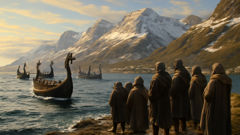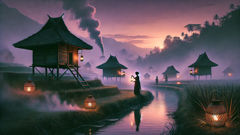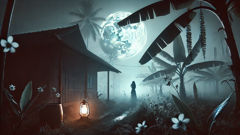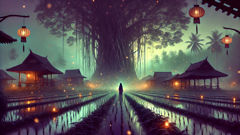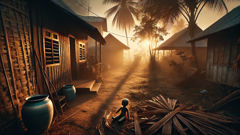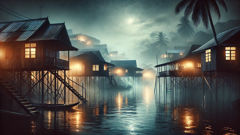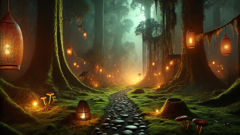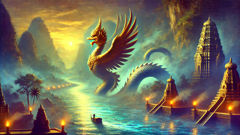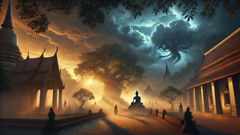Introduction
Across the wind-scoured coasts of Iceland and Greenland, stories lived longer than men. They were carried on salt-laden breezes, told in smoky turf halls beneath the glow of oil lamps, woven into the tapestry of a people shaped by the sea. In these harsh northern lands, the Norse were both survivors and dreamers—descendants of those who fled the crowded fields of Norway for the promise of freedom and green pastures across the ocean’s expanse. Among these hardy souls, a new generation was rising, restless under the weight of their ancestors’ legends. None felt this more keenly than Leif Erikson, son of Erik the Red, whose own saga was steeped in exile and exploration. From his earliest days, Leif’s world was one of extremes: summers where daylight never faded, winters when darkness ruled, and always the ocean—a merciless, life-giving border. He listened to tales of distant lands glimpsed beyond the western horizon, whispered of by sailors and outlaws alike. Some called it Vinland, land of wild grapes and endless forests, a place rich and strange, waiting to be claimed. For Leif and his kin, shaped by a landscape that demanded courage, such rumors were more than idle dreams. They were invitations to act. This is the saga of the Greenlanders: a tapestry of hope, loss, and the longing for a place to call home—a story that would echo through centuries, bridging the old world and the new.
Greenland’s Edge: The Legacy of Erik the Red
Greenland in the closing years of the 10th century was a paradox: a land of both promise and hardship, where the Norse settlers—led by Erik the Red—carved out a tenuous life on the fringes of the known world. Erik’s name was spoken with awe and a measure of fear; he’d been exiled from Iceland for murder, and it was in Greenland’s fjords that he’d staked his final claim. The settlement at Brattahlid was the heart of this colony, its turf halls bustling with the clang of blacksmiths’ hammers, the laughter of children, and the urgent prayers of mothers as storms battered their fragile homesteads.
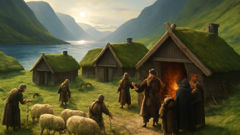
Leif Erikson grew into manhood here, his character forged by the same icy winds that battered the cliffs. He was tall, broad-shouldered, with keen blue eyes that missed nothing—a born sailor, yet thoughtful, often found listening in silence while elders recounted the feats and failures that had brought them to this place. Erik, for all his bluster and wild temper, saw something in his son that reminded him of himself: a hunger for more than mere survival.
It was in the long shadows of winter that tales of lands to the west grew boldest. Ships returning from hunting voyages brought news of driftwood unlike any found in Greenland, of the faint scent of pine on the wind. One evening, as snow hissed against the hall’s sod roof, an old mariner named Bjarni Herjolfsson arrived at Brattahlid. He spoke of being blown far off course and glimpsing a wooded shore—land neither charted nor claimed. His words were met with skepticism and envy in equal measure, but for Leif, they ignited something deeper: a vision of forests untouched by axe, rivers brimming with fish, and fields waiting to be sown.
Erik the Red, though proud, urged caution. The sea that had granted them Greenland could just as easily swallow their hopes. Yet Leif was undeterred. Preparations began in secret at first—a gathering of trusted men, the repair of a sturdy longship, supplies of dried fish and cured meat, axes honed for both wood and defense. Word spread, and soon others wished to join, eager for adventure or desperate to escape the privations of another Greenland winter. Among them were his foster brother Tyrkir, wise in the old ways; Thorvald, his quick-tempered sibling; and Freydis, their fierce and unyielding sister.
The night before their departure, the settlement gathered for a feast. Hopes mingled with fears as the mead flowed and the skald recited poems of Odin’s wanderings. Leif stood in the firelight, uncertain yet resolute, aware that his decisions would shape not only his own fate but that of generations to come. As dawn broke, painting the fjord with pale gold, the longship slid into the water. Erik watched his son depart with pride—tinged, perhaps, with sorrow. For in Greenland, every journey began with a farewell, and not all who ventured into the unknown would return.
Sailing West: Peril and Promise on the Open Sea
The departure from Brattahlid marked the beginning of a journey both physical and spiritual. As Leif’s ship cut through the fjord’s calm waters and out into the open sea, a hush fell over the crew. The Greenlandic coast soon shrank behind them, replaced by endless blue and the wheeling cries of seabirds. Every man and woman aboard was aware of the risks: storms that could appear with no warning, icebergs looming like silent giants, and the ever-present possibility of losing their way entirely.
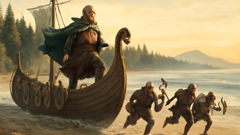
Leif stood at the prow, eyes fixed on the horizon. He trusted in his ship—its oak ribs flexed to withstand the North Atlantic’s fury—and in his people. Tyrkir, ever vigilant, watched the clouds and read the stars, murmuring old prayers in his native tongue. Freydis kept order among the younger sailors, her authority unquestioned. Thorvald’s laughter rang out even in the face of gathering squalls, his bravado a shield against fear.
The first days passed with favorable winds and spirits high. They fished for cod and herring, caught seabirds, and shared tales to ward off the monotony. But as they pressed further west, the weather turned. The sky darkened to iron; the sea rose in great green swells that threatened to swallow the ship. For days, they battled the elements—sails reefed, oars manned in shifts, hands blistered and raw. Sleep became a luxury, food lost its taste, and even the bravest whispered Odin’s name into the storm.
One night, as lightning flickered across the sky and the wind howled, a cry rang out from the masthead: land! At dawn, they saw it—low hills thick with forest, a shore fringed with white sand and wild grass waving in the breeze. Their relief was tempered by caution. Was this the fabled Vinland? Or merely another uncharted island in the western sea? Leif ordered a landing, and the crew staggered onto firm ground, overcome by the scent of earth and pine.
They explored cautiously, axes ready but hearts swelling with hope. The land was rich beyond imagining: rivers teeming with salmon, wild grapes hanging in clusters, groves of maple and birch. Tyrkir, wandering off in search of food, returned wild-eyed and laughing—he had found grapes, proof that they had reached the land spoken of in rumor and song.
They named the place Vinland, for its bounty. Camp was made among the trees, and for the first time in weeks, the Norse slept deeply, lulled by the gentle sigh of wind through the branches. Yet even in this newfound paradise, Leif knew their trials were not over. The land was beautiful, but unknown. And always, in the shadows, new dangers waited.
First Encounters: Discovery, Conflict, and Kinship in Vinland
Vinland’s abundance was both blessing and challenge. The Norse built shelters from timber, marveling at how easily the land yielded what Greenland denied. They hunted deer in the forests, gathered berries by the riverbanks, and preserved fish for the long winter. Each day brought new discoveries: flocks of birds darkening the sky, rivers wider than any in Iceland, and a hush in the woods that hinted at mysteries yet unseen.
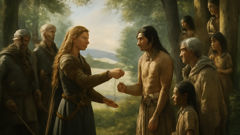
As autumn deepened, the Norse realized they were not alone. Tracks appeared near their camp—footprints too small to belong to any among them, fire pits left smoldering by unseen hands. At night, they heard distant laughter and glimpsed shapes moving at the forest’s edge. It was Freydis who first made contact. Out gathering berries, she came upon a group of indigenous people—Skrælings, as the Norse called them. They watched each other warily across a clearing, neither side making a move. Freydis lowered her weapon first, offering a string of glass beads. After a tense silence, one of the Skrælings stepped forward, accepting the gift with a shy smile.
This first exchange led to cautious bartering. The Norse traded metal tools, cloth, and bright trinkets for furs and smoked meat. Tyrkir, with his gift for languages, tried to learn their words. Some among Leif’s crew viewed the newcomers with suspicion, recalling tales of treachery and war from their homeland. Others saw an opportunity for friendship and learning. For weeks, peace held. The Norse and Skrælings shared food and stories around their respective fires, each fascinated by the other’s ways.
But tension simmered beneath the surface. The Norse were few in number, their weapons formidable but limited. The Skrælings, skilled hunters familiar with every path and river, watched with wary eyes. One morning, a misunderstanding sparked conflict. A Norseman, thinking himself cheated in trade, seized a valuable pelt from a Skræling woman. Voices were raised; spears and axes glinted in the sun. Leif intervened swiftly, returning the pelt and offering gifts to restore peace. Blood was avoided—for now.
Winter arrived suddenly, blanketing Vinland in snow. The Norse huddled in their timber halls, sharing stories to keep fear at bay. Food grew scarce. The Skrælings withdrew deeper into the woods, their visits becoming less frequent. Leif struggled to maintain unity among his people, his authority challenged by hunger and doubt. It was then that Thorvald proposed an expedition further south, seeking new resources—and perhaps a safer home.
The journey was perilous, marked by storms and skirmishes. Thorvald was wounded in an ambush and died soon after, buried beneath a cairn overlooking the endless forests. His loss weighed heavily on Leif and Freydis, who returned to camp changed by grief. In the spring, as ice melted from the rivers and birds returned, Leif gathered his people. Vinland, for all its beauty, was not to be their permanent home—not yet. But their courage had left its mark on both land and legend.
Conclusion
The saga of the Greenlanders did not end on Vinland’s shore. Though Leif Erikson and his companions eventually turned their sails eastward, their spirits forever carried the memory of wild forests and new friends—and of loved ones lost beneath unfamiliar stars. Their story became legend, woven into the heritage of Iceland, Greenland, and beyond. For generations, Norse children grew up hearing of the land across the sea, where courage met adversity and hope was kindled by every sunrise over unknown hills. Leif’s voyage proved that the world was vaster than anyone had imagined, and that even on the harshest edges of existence, the will to explore—to risk, to connect, to dream—remained unbroken. Today, centuries later, the tale of Vinland still stirs our hearts. It reminds us that history is made not just by those who conquer, but by those who seek understanding: who offer a hand rather than a weapon, who cherish every glimpse of beauty in a strange new world. The Greenlanders’ saga is a monument to human resilience—a testament to the power of courage, curiosity, and the undying hope for a better tomorrow.

